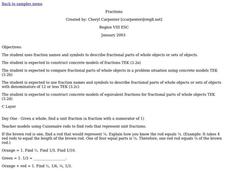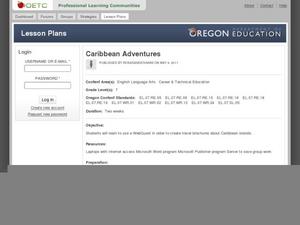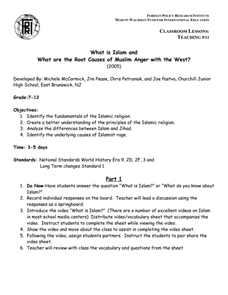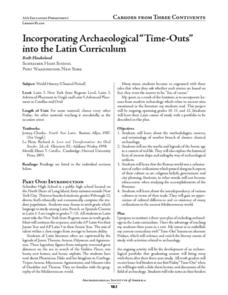Curated OER
Ocean Life: A Heavy Subject
Second graders examine The Learning Page Fact Files about ocean life and categorize the data by weight and group. They distinguish between fish, mammals, and invertebrates and which weigh the most and the least. Students record their...
Curated OER
Tour + Workshop = DESIGN: Shape
Ask elementary pupils to explore shapes in everyday objects. They will discuss the elements of design and describe the shapes they see in visual images. Students will then design and "build" a new 3D shape. Finally they will show and...
Curated OER
Fractions
Young mathematicians use fraction names and symbols to describe fractional parts of whole objects or sets of objects. They construct concrete models of fractions, and compare fractional parts of whole objects in a problem situation using...
Curated OER
Oral Presentation
Practice your speaking skills! Using a chosen visual aid, pupils present a previously written essay to the class. During the oral presentation, the listeners identify and write down the author's purpose and a question for the author. At...
Foreign Policy Research Institute
Understanding China: The Prospects for Democracy in China
This document provides useful information for a unit on democracy in China. While it does not include detailed activities, it does have a list of democratic principles, and important facts about China that facilitate understanding of its...
Curated OER
5 Types of Chemical Reactions and a Lab on Mole
Students recognize the concepts of the five general types of chemical reaction: combination, decomposition, single replacement, double replacement and combustion. They practice classifying chemical equations and determine the moles in a...
Alabama Learning Exchange
Are You a Square or a Rectangle?
Discover the difference between standard and non-standard units of measure with your class. They differentiate between rectangles and squares, read a book, measure a peer's height. They then discuss measurement methods, make...
Curated OER
Is Your Money Rolling Away?
Young scholars demonstrate how to solve word problems. They will watch the video "Math Can Take You Places" and identify three problem solving strategies.
Curated OER
Animal Keynote Report
Learners produce a research project on an animal. Using the Internet, they find pictures and information about animals. They are also given a list of items that should be covered in their report, including the appearance of the animals,...
Curated OER
Author! Author!
Beverly Cleary is the fabulous author focused on, in this author study. Students conduct Internet Research in order to find out as much as they can about Ms. Cleary. They then use their findings and the Garageband program to create a...
Curated OER
Biomes Newsletter Report
If your class will be studying biomes and you also want to address some technology standards, check this out! Each class member becomes an expert on 1 biome through online research, and writes a 4-page report that covers climate,...
Curated OER
Caribbean Adventures: Research and Desktop Publishing
If you want an interesting way to teach about the Caribbean that incorporates technology, this might be your answer. Class members conduct a WebQuest to gather information about Caribbean islands and create a travel brochure using...
Curated OER
Collaborative Editing
With the use of an online editing site, budding authors revise their writing. This is a creative way to have your class practice essay revision. Instead of being a tedious process, editing and revising can be fun.
Curated OER
Rhyming Words
Rhyming words are good for young readers to explore. Just ask Dr. Seuss! This basic presentation shows learners 12 pairs of simple words that rhyme such as: two and blue. Pupils practice reading each of the rhyming words as they appear...
Curated OER
Use of Water
What type of things can one do with water? You can swim in it, wash with it, drink it, and use it to do your laundry. It is also so much fun for swimming! Water is an amazing resource! Quiz your kids on all the different ways they use...
Curated OER
2-D Shape Recognition
How many of 2-D or plane shapes can your class identify? Can they get them all? Little learners view and review the names of nine different shapes, such as rectangle, square, triangle, and circle, to name a few.
W.K. Kellogg Biological Station
Succession: Patterns in the Field and in Seeds
Have you been wondering how to use that natural trail at or near your school? This activity gets kids outside with a purpose: learn about ecological succession through field observations and collecting seed and soil samples. The resource...
Curated OER
What Shape is That?
Each country or group of people has created special places of worship. Children read a story about religious buildings and architecture and then make clay models of the buildings they like the best. The lesson has been written to...
Texas Education Agency (TEA)
Build a Paper Structure
Who knew that paper is an amazing building material? Scholars learn about the properties of planar materials, such as paper, as well as their structural capabilities in the sixth lesson a series of 11 on architecture. Working in groups,...
Foreign Policy Research Institute
What is Islam and What are the Root Causes of Muslim Anger with the West?
A video and magazine article provide the foundation for learning about Islam and why some Muslims are angry with Western society. In groups, learners identify the causes of hostility and prepare a presentation that explains them. While...
Curated OER
Incorporating Archaeological "Time-Outs" into the Latin Curriculum
Here is a lesson whose focus is on classical archaeology. In groups, high schoolers read various myths and legends to examine the how the culture was passed between different groups. They participate in a role-play activity in which they...
Curated OER
Sum of Integers
In this sum of integer worksheets, students formulate and prove the sums of cubes. They explore a quadratic polynomial, cubic polynomial and solve with systems of equations. This two-page instructional activity contains eleven problems.
Curated OER
The Great Pollinators
Young scholars discover the reproductive parts of a plant. In this biology lesson, students identify and categorize several different plants they dissect in class. Young scholars record their information using a data chart.
Curated OER
Translating Verbal Phrases into Symbols
In this Algebra I learning exercise, 9th graders translate verbal phrases into algebraic expressions. The one page learning exercise contains six multiple choice problems. Solutions are provided.
Other popular searches
- 2d Shapes
- 2d and 3d Shapes
- Math 2d Shape
- Properties of 2d Shape
- 2d Polygons
- Geometry 2d Shapes
- Classifying 2d Shapes
- Describing 2d Shapes
- 2d Models
- Symmetrical 2d Shapes
- 2d Shapes Art
- Geometry and 2d Shapes























